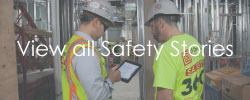United States


Weather
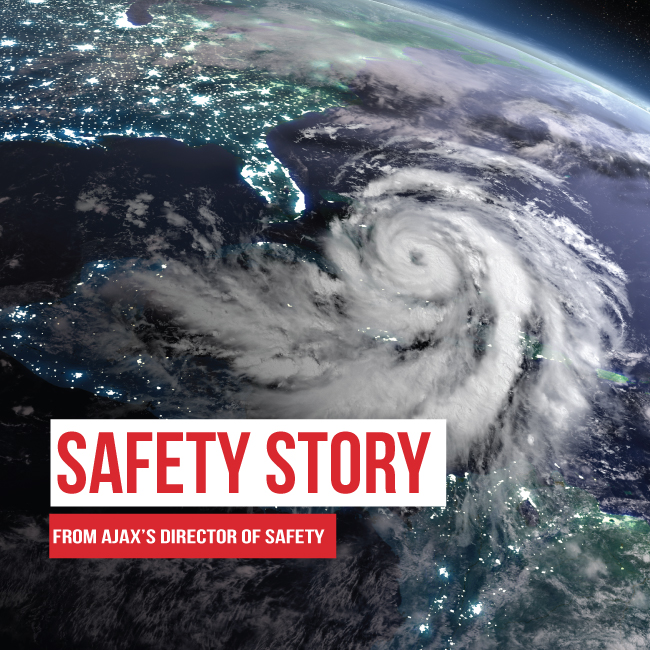
Ajax Project Manager
In mid-2017, Ajax had just started a project in Key West, FL when the news starting airing warnings about Hurricane Irma. Due to our remote location and the likelihood of a mandatory evacuation, we began preparing the site over a week in advance. Since the site was waterfront and only a couple of feet above sea level, we were extremely concerned about flooding. Conex boxes had to be strapped down with helical anchors, wind screens were taken off the fences, and all piping, conduits, etc. were strapped together and weighed down so nothing would float away. We were still in the early stages of the project and completing foundation work, so we weren’t concerned with how the damage would impact the finishes. Foundations were placed the day before the evacuation to prevent the loss of formwork.
When we were finally able to return to the project nearly two weeks later, thankfully the site hadn’t taken too much of a beating. The greatest physical damage was to the silt and perimeter fences, where the surrounding mangroves and miscellaneous debris had blown into the site. Power and data lines were also down, but they were fixed within a few days. The biggest challenge we faced after the storm was the loss of manpower. A portion of the workforce had lost their homes in the storm and immediately moved out of The Keys.
In the end, we were able to get the project running again. It’s now a beautiful new school for the community.
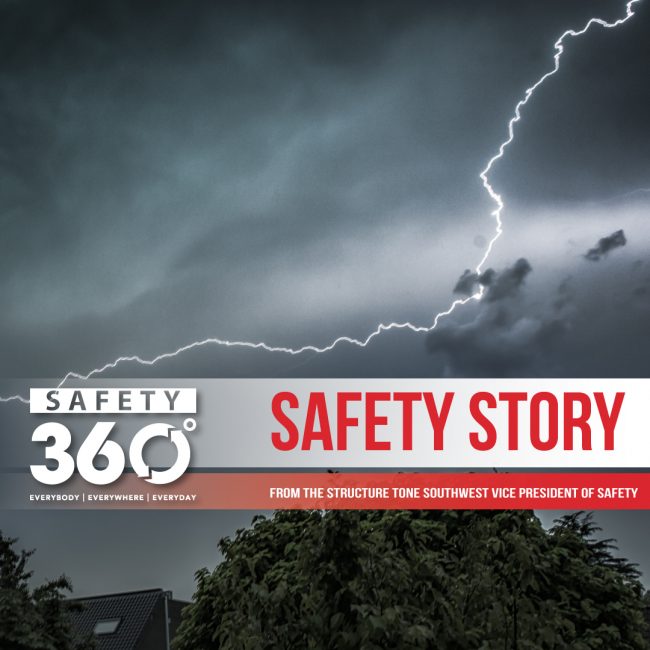
A Safety Story from Structure Tone Southwest Vice President of Safety
Summer is officially here, which means it’s time for summer storms and weather preparedness. In 2020, the National Safety Council reported 60,174 weather-related events, which resulted in 585 deaths and 1,708 injuries. We all should have a plan to address irregular weather events and emergencies at home or at work.
At Home:
1. Make sure someone at home is trained in first aid and CPR.
2. Have a family communication plan in place and practice the plan, whether sheltering in place or going through evacuation scenarios.
3. Keep an emergency kit in your vehicle.
4. Store important documents (e.g., birth certificates, insurance
policies) in a fire safe.
5. Know where the shut-off valves are in your home.At a Jobsite:
1. Make sure to have and communicate a current
Emergency Action Plan.
2. Practice what you preach. Walk through the plan to shelter in
place, evacuate, shut off utilities, report events, etc.
3. Make sure someone is trained in first aid and CPR.
4. Be prepared to tie down materials and store them properly.
5. Be prepared to shut down lifts and cranes.
6. Know where shut-off valves are and let others on-site know as well.
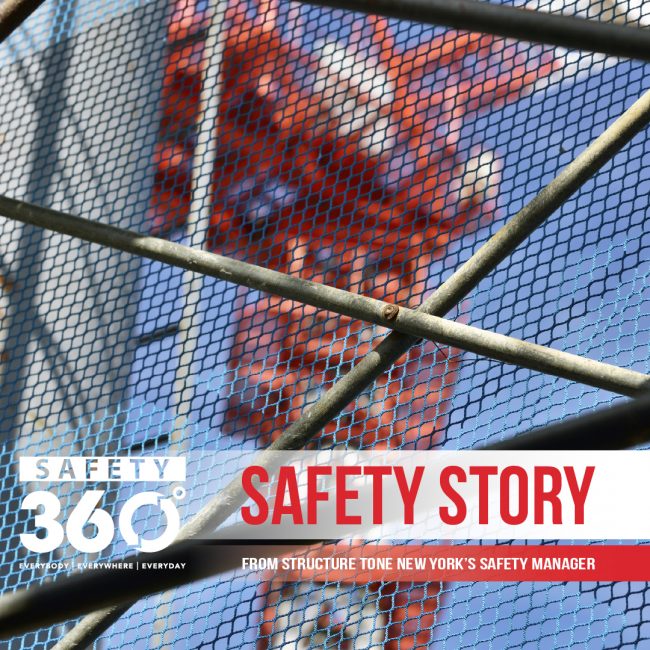
A Safety Story from Structure Tone New York’s Safety Manager
One day, I walked into work, checked in on a few things, and proceeded to the field. The DOB issued a high wind weather warning for that evening into the following day. I quickly forwarded the warning to the GCs on my sites and proceeded to 55 Hudson Yards. I walked the roof, setbacks, and the first-floor park enclosure to confirm we didn’t have any loose debris laying around. Once on the ground, I noticed the suspended scaffold was going up and stopped approximately halfway up the building. I felt it was my responsibility to make sure the core installation GCs knew about the weather warning for that evening. I called the foreman a few times, and when he didn’t answer, I took the hoist to the 26th floor and walked down until I located the suspended scaffold on the 22nd floor. As I got closer to the window, I noticed the foreman wasn’t there. I tried to communicate with one of the workers through the window. I raised my hand to my head to motion “call,” and he signaled “yes” with his head. He put his cell phone to the window, and I dialed the employee’s cell number. I briefly mentioned the high wind advisory and asked the employees to yank on their fall protection to confirm all they were all tied in. One of the core installation contractor’s long-time employees realized he hadn’t been tied in and immediately latched his fall protection into the correct tie-off point. He informed me that he was tied in, and I reiterated the importance of the buddy system and proceeded to the ground and went back to the office for a meeting.
During my meeting, I received a phone call from one of the other contractors’ safety managers. I walked outside to take the call and she frantically stated, “We called 911! A huge gust of wind pulled core install’s scaffold away from the building and slammed it back into the building. The workers were on their way down on the north elevation and another gust of wind came and swung the scaffold around the building onto the east elevation and now they’re stuck. The fire department is here breaking the windows to help get the employees into the building because the scaffold is stuck!” I went to my desk, grabbed my hardhat and vest, and ran to the site. There were ten fire trucks, three ambulatory trucks, and five police cars. At that moment, they weren’t letting anyone near the building. They had cordoned off the area due to the broken glass and the scaffold, partially in the building. I waited patiently, hoping, and praying that my friends were alright. After about an hour, the core installation guys were wheeled out into ambulances one by one. I was so thankful! As I started to walk away, I heard the veteran employee I spoke with earlier in the day shout, “Hey, you saved my life!” I gave him a thumbs-up as they wheeled him onto the ambulance. You could hear him explaining to the paramedics how he had been reminded to tie in just a few hours ago.
The moral of the story is complacency can be a silent killer. Always focus and ensure everything is done correctly.

A Safety Story from Ajax’s Director of Safety
Hurricanes are the largest and most powerful storm systems on earth. They are capable of catastrophic destruction throughout large areas along the Gulf and East Coasts of the United States and for many miles inland. On October 10, 2018, Hurricane Michael came ashore in the Florida panhandle near Tyndall Airforce Base as a category 5 storm with winds in excess of 150mph. Michael did an estimated $18.4B in damage in Florida alone, and estimates for damage throughout the US approached $25B. Even more tragically, 74 deaths resulted from this storm. When driving through the areas impacted by Hurricane Michael, one can still see effects of the storm nearly three years later.
Each year, the Atlantic hurricane season starts on June 1st and runs through November 30th. The National Oceanic and Atmospheric Administration (NOAA) is predicting the 2021 Atlantic hurricane season storm activity to be “above normal.” NOAA’s outlook estimates there to be 13-20 named storms, 6-10 hurricanes, and 3-5 major hurricanes. It only takes one storm to devastate a community, and now is the time for businesses and residents along coastal areas, as well as inland, to start preparing for the 2021 hurricane season. Remember, the more violent the storm, the quicker it passes.
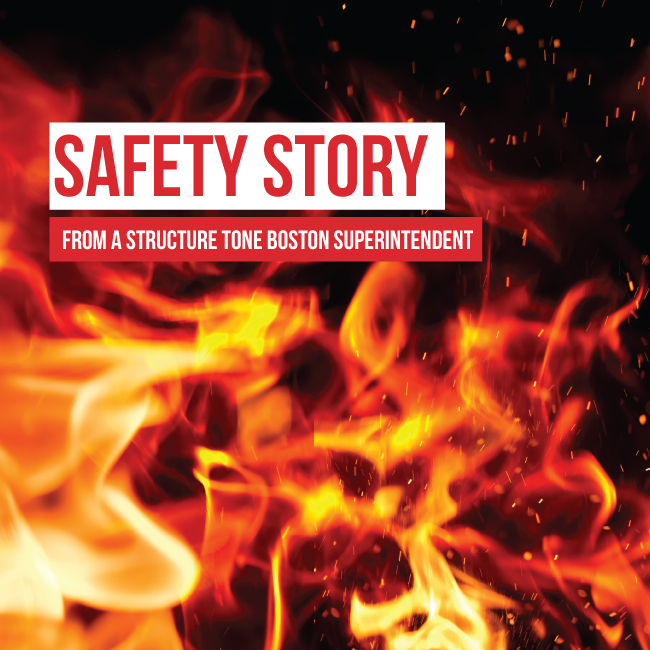
A Safety Story from Structure Tone Boston Superintendent
Earlier this year, my home caught fire and was completely destroyed. The fire investigators think the fire started when someone discarded a lit cigarette in the alley behind our house, and then a gust of wind blew it into some dry leaves and grass under our back porch. In a matter of minutes, the whole back of the house and three of our vehicles were fully engulfed. Only a few minutes after that, the entire house was ablaze and there was no stopping it.
The biggest lesson I learned throughout this experience—and a message I’d like to convey to everyone—has to do with disaster preparedness. Everything in our house was a total loss, and although we had good insurance, we didn’t have adequate records or an inventory of our possessions, so we had to work from memory when filing our claim. I’m sure we left many things out. You really never know what could happen, so do your best to prepare for the unexpected.
Our house is currently being rebuilt and should be complete by next summer. Thanks to the generosity of many people, including my STOBG family, we have everything we need to get by until we are moved back in and settled again.
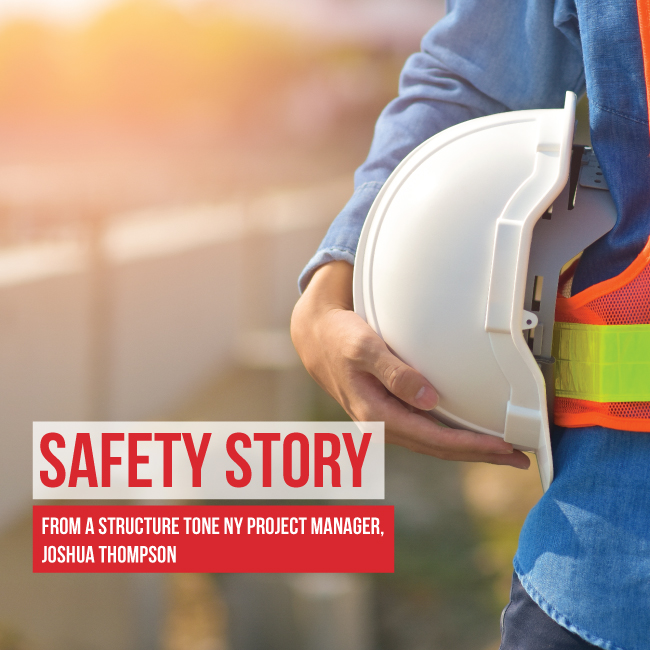
A Safety Story from a Structure Tone New York Project Manager
In 2007, I was working on an out-of-the-ground office tower for a prominent financial firm in Northern Virginia. The building was positioned on a small hill and was exposed to frequent wind. One day we were expecting a severe thunderstorm, so we used weights to secure sheets of Masonite to protect the roof. We had a large landscaping crew working to finish the grounds around the building that day as well. Our superintendent had made his rounds right before the storm hit and told all the landscapers to put on their hard hats, as they were not wearing them. The storm came early and caught us by surprise. As the storm came in, the wind picked up a piece of the Masonite that had been secured under a weight and sent it end-over-end across the roof and off the side of the building. The Masonite ended up hitting one of the landscapers on his hard hat, which he had just put on. The Masonite made a large gash through the worker’s hard hat, but his PPE saved his life. Our superintendent took a few extra minutes to remind the landscaping crew about their hard hats and it made a huge impact. It’s a day I will never forget throughout my career.
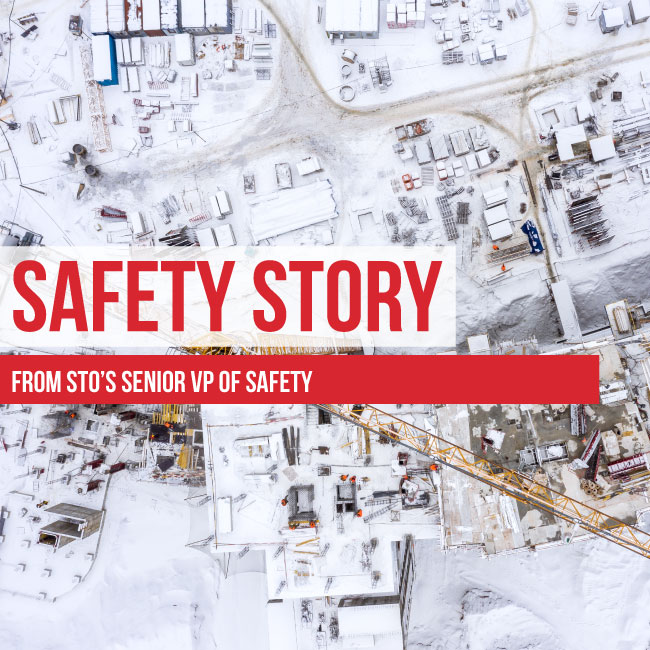
Safety Story from STO Building Group’s Senior VP of Safety
Blizzards always remind us that significant snow brings significant hazards—especially on site. Nothing emphasized this more than the New England Blizzard of 2015. After nearly 25in of snowfall in Boston, site crews had to contend with completely obscured walkways and concrete depressions—not to mention the utility stub-outs, rebar, and other hazards that were invisible underneath the snow. Site roadways that were usually easy to navigate become a dangerous trek when drivers couldn’t see the path or the surface changes below. Outward-swinging doors were blocked by snow, even though proper overhead protection was in place. Exposed stair towers and handrails froze over with ice, snowblowers were damaged by unseen objects beneath the snow, and drains were quickly blocked by snow causing backups and pooling. Fences were toppled due to highspeed winds and snow sticking to the scrim. Ramps and stairs were shoveled, but soon covered again with snow and ice—a slippery proposition at best.
Large amounts of melting snow and ice dropped from building canopies high above. Roofs had to be cleared due to the hazardous weight of the snow. Pooled water froze over as temperatures dropped. There were few places left that we could put the snow we were removing and finding additional generators, gas, plows, and ice melt was nearly impossible.
The lesson here is snow can be dangerous. Even the slightest bit on site or on the road can turn to ice and become deadly in an instant. The best way to stay safe is to have a plan in place, communicate with your crew, and proceed with thoughtful caution—always.
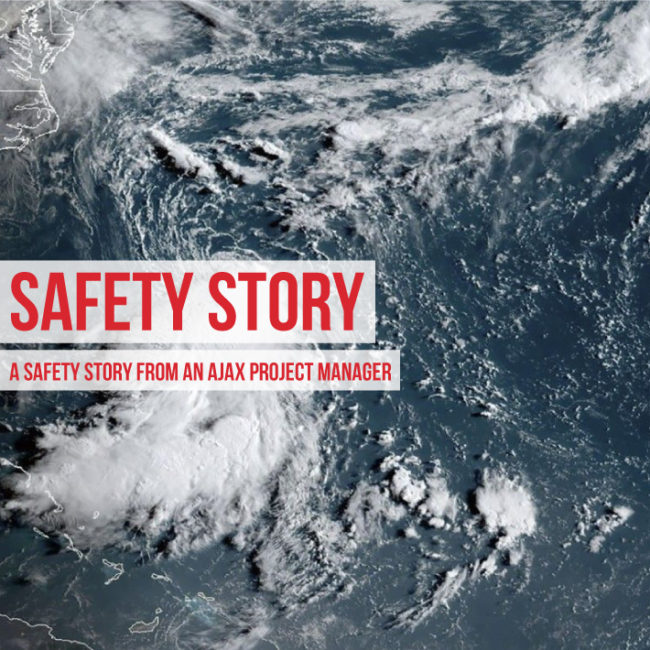
A Safety Story from an Ajax Project Manager
In mid-2017, Ajax had just started a project in Key West, FL when the news starting airing warnings about Hurricane Irma. Due to our remote location and the likelihood of a mandatory evacuation, we began preparing the site over a week in advance.
Since the site was waterfront and only a couple of feet above sea level, we were extremely concerned about flooding. Conex boxes had to be strapped down with helical anchors, wind screens were taken off the fences, and all piping, conduits, etc. were strapped together and weighed down so nothing would float away. We were still in the early stages of the project and completing foundation work, so we weren’t concerned with how the damage would impact the finishes. Foundations were placed the day before the evacuation to prevent the loss of formwork.
When we were finally able to return to the project nearly two weeks later, thankfully the site hadn’t taken too much of a beating. The greatest physical damage was to the silt and perimeter fences, where the surrounding mangroves and miscellaneous debris had blown into the site. Power and data lines were also down, but they were fixed within a few days. The biggest challenge we faced after the storm was the loss of manpower. A portion of the workforce had lost their homes in the storm and immediately moved out of The Keys.
In the end, we were able to get the project running again. It’s now a beautiful new school for the community that has been in operation for almost a year now.
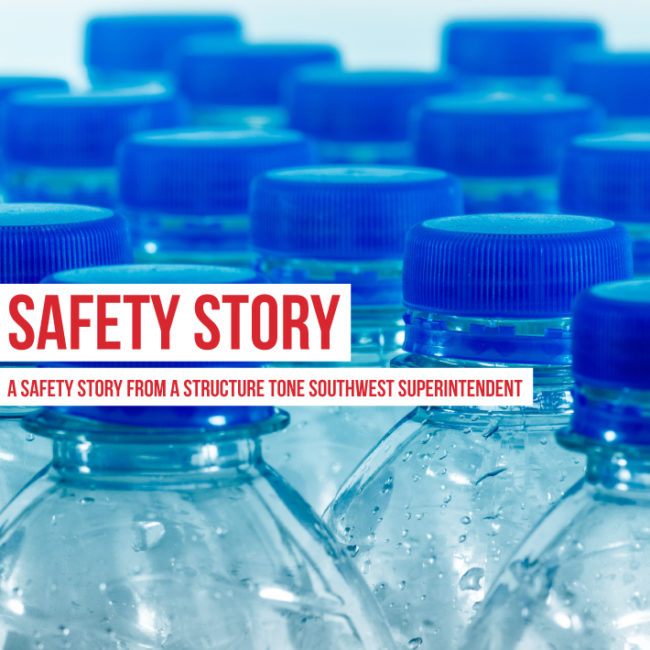
Safety Story from a Structure Tone Southwest Superintendent
When I was in junior high, my father worked for the City of San Antonio as a truck driver. My dad was a big man—6’4” and about 260lbs. It was a hot summer, and I remember my mom getting a phone call that my dad had been rushed to the hospital for heat stroke. It was a scary moment, but thankfully he recovered and returned to work a few weeks later.
My background is in mechanical/HVAC systems, so 99% of the time, my crew and I weren’t working in air-conditioned spaces. We had to work on the roof, setting equipment in the scorching South Texas heat. There were many times that we started our shift extra early in the summer to avoid peak temperatures. Because of these experiences and the incident with my father, I know how important it is to stay hydrated in extreme heat. I’ve always made it a point to make sure my crew and others on the jobsite have access to clean water and take breaks to cool off.

